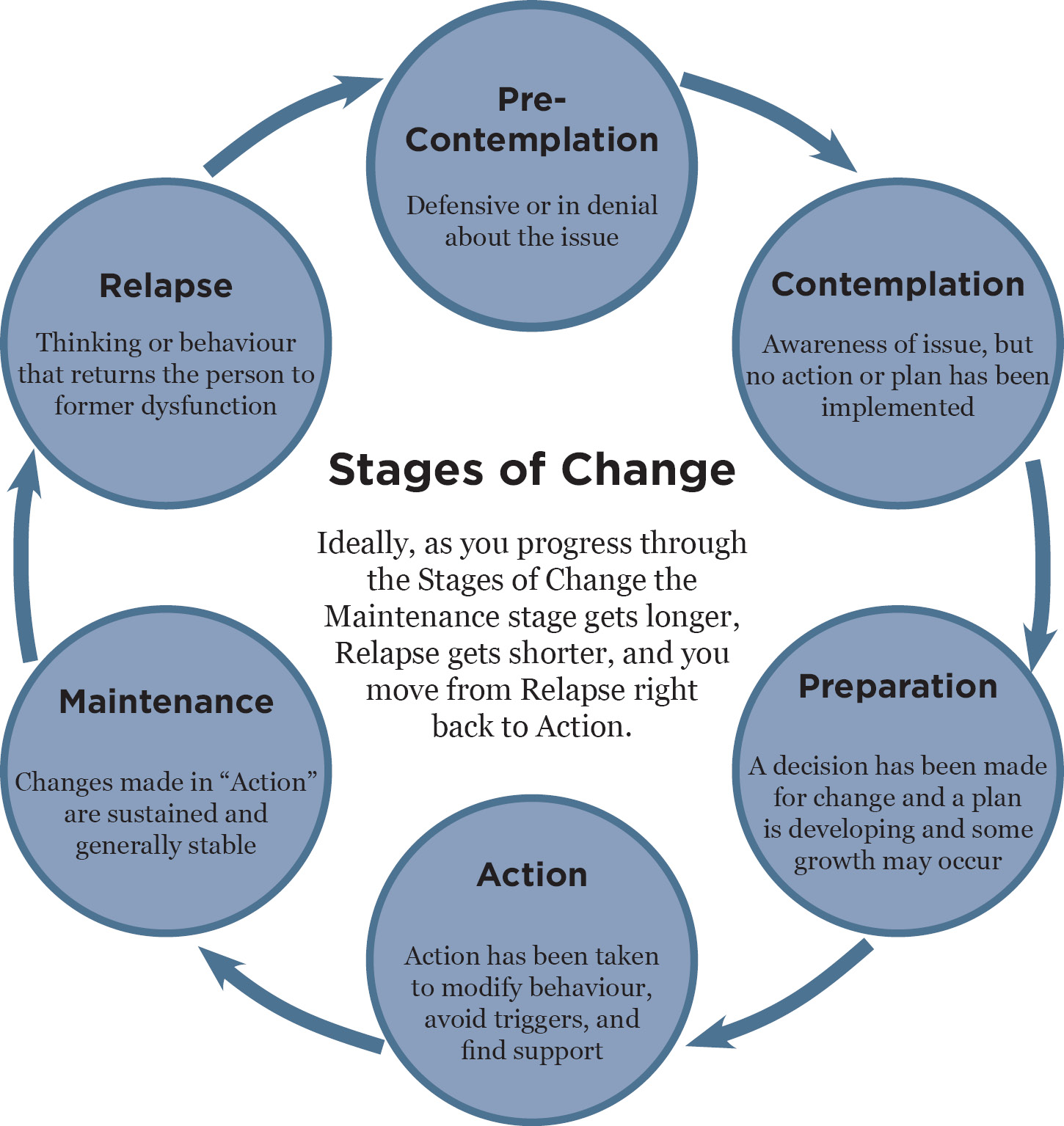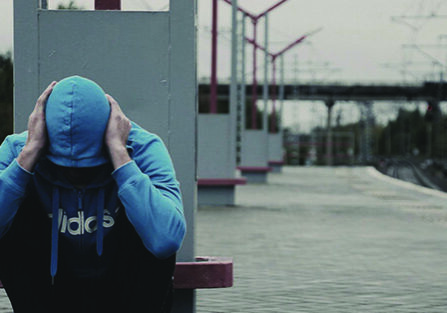
Stages of Change
The Stages of Change are based on the Transtheoretical Model created by Carlo DiClemente and James Prochaska. Whether you are addressing behavioural issues or substance abuse, this model may be helpful in understanding and communicating the progress and trajectory of a struggling person.
There are six “Stages of Change” which are as follows:
1) Pre-contemplation
2) Contemplation
3) Preparation
4) Action
5) Maintenance
6) Relapse
At the end, we’ll also examine the life of Paul, Peter, and Judas as examples of these Stages in action.

Pre-contemplation
In the pre-contemplation stage, the individual is not yet considering or intending to modify their behaviour. They may be unaware of the consequences of their current behaviour or underestimate its impact on their lives. They may have tried unsuccessfully to change in the past and feel resigned or unmotivated to try again. Alternately, they may be fully aware of the destructive nature of their behaviour but be so enmeshed in it that they lack any desire for change.
At this stage, interventions and efforts to promote change are likely to be ineffective and poorly received. For change to occur, the individual must want change to occur. Change cannot be forced on them. Raising awareness and providing information about the potential benefits to change may help move them from pre-contemplation into the next stage of change.
Contemplation
When a person recognizes the need for change and is seriously considering making a change, they have entered the Contemplation stage.
At this stage, the person is aware of the negative consequences of their behaviour and is genuinely considering whether or not this is the direction that they are wanting to continue or if they want to adopt new behaviours. During this time, they will be weighing the pros and cons, considering the challenges of change, and reflecting on whether or not they have the necessary skills, resources, and motivation to change.
If they feel like the obstacles before them are too great, they may return to the pre-contemplation stage. During this time, we recommend encouragement and support as they weigh all these possibilities. Let them know that you are there to help them move forward in the process.
Preparation
Once the person has decided for themselves that they are wanting to make a change and are willing to put in the time and effort to make a change, they must decide how they plan to achieve this goal.
During this stage, they will be actively planning and taking steps to overcome destructive or unwanted behaviour. Setting goals, seeking out resources, and finding support are all positive ways that they prepare for the challenges ahead. Who can they turn to? What can they do when they stumble? What tools do they already have at their disposal? It is likely during this time that small improvements and changes will be made in anticipation of the larger changes to come.
We recommend that you largely allow them to put these pieces in place for themselves. You should be a support, an encouragement, and offer advice when it’s requested, but the person seeking to make a change needs to take ownership of their plan.
Action
With the framework for change already laid, now is the time to put the plan into action. They are making a conscious effort to adopt new behaviours and eliminate old ones.
This is the implementation of the Preparation stage. They are taking meaningful actions to achieve the desired change. The efforts should be observable and measurable. Take the time to celebrate milestones and victories because this stage takes a great deal of intentionality and effort. As time marches on, the enthusiasm and resolve may begin to waver as obstacles rise up.
Continue to support and encourage through this process. Recognize that change does not happen overnight and that struggle is a necessary part of lasting change. Don’t become overwhelmed by the day-to-day, but try to keep a long-term outlook and realize how much change has already happened to encourage further growth.
Maintenance
After three to six months in the action stage, you will hopefully see the person enter the Maintenance stage. They have successfully modified their behaviour over the long term and integrated it into their lifestyle.
Instead of days typified by consistent effort and struggle, the resources, support, and practices have integrated themselves into the person’s life. The new behaviour has become a long-term habit. Continue to celebrate major milestones and encourage the individual by affirming how you have seen them change.
The goal of the Stages of Change is to live in this stage. To reinforce and create long-term resiliency to the old patterns. Recognize that the person in the Maintenance stage needs less direct help, but should still be reached out to and encouraged regularly.
Relapse
The unfortunate reality is that relapse is a part of many people’s journey.
Relapse can happen at any stage of the cycle, but please know that relapse does not negate all the positive that has come out of the struggle. Each time a person moves through the Stages of Change, they have laid the groundwork for the next time. Like retraining a muscle, the person has the opportunity to move through the stages faster and remain in Maintenance longer. Perhaps indefinitely.
Relapse begins in the mind. It’s not the first time that an addict uses drugs again or a behaviour resurfaces that the relapse has taken place. Relapse likely began much earlier, in the mind, when old patterns and ways of thinking were entertained.
Of particular note: Be aware of weddings and funerals. Most relapses tend to occur during major family events.
Saul moving through the Stages of Change
Probably one of the clearest examples of someone moving through the Stages of Change would be Saul’s conversion.
Precontemplation
Saul was zealously hunting down Christ’s followers. Christians the world over were terrified of him to the point that even after his conversion there were those who believed it to be a ruse to draw the faithful out of hiding. At this point in his life, Saul didn’t even entertain the possibility that he was in the wrong. He was faithfully doing what he fully believed to be the work of God.
Contemplation
On the road to Damascus, Saul was thrown from his horse when a vision of Christ spoke to him. Suddenly he had to come face to face with the reality of his actions. They were not pleasing to God, as he had originally thought. He was suddenly aware of his need for change.
Preparation
The realization led to a time of intense preparation for Saul. Unlike most people who need a radical change, Saul had all the knowledge he needed. What he needed was time to process and understand the scripture based on this revelation. He spent three years in Arabia preparing, though this Stage usually only lasts for around a month when implemented for behaviour change.
Action
Saul wasn’t content to allow his transformation to be a purely personal experience. He ensured that everyone knew about the change in his life. He wasn’t the same as he was before and he wanted others to know it. He presented himself to the apostles, challenged the Pharisees, and changed his name to Paul so that people would know that though he was the same man, he was also a different man.
Maintenance
He continued to preach, write, and spread the word of God for the rest of his life. He performed miracles, put his life in jeopardy, and lived as God had called him to even if it would lead him to his grave.
Though Paul never ‘relapsed’, there is one good contrasting pair that we can use as examples of this principle. Peter and Judas
Relapse
Peter and Judas are a good example of relapse in the bible. Both of these men spent three years with Christ as He preached, healed, and lived as no one else could.
Judas betrayed Jesus, Peter denied Jesus. Both of them were broken by their actions.
In the end, Judas hangs himself. He was so overcome by his despair at betraying Christ that he couldn’t continue.
Peter, on the other hand, does not allow himself to be overwhelmed by the despair, but neither does he immediately return. He goes back to the Sea of Galilee and starts fishing. He goes back to his old day job, his old ways. He’s screwed up and likely doesn’t think of himself as able to return to how things were. It takes Christ coming, pulling him aside, and encouraging him to have Peter realize that failure isn’t the end of his story.
And relapse doesn't have to be the end of your story either.
Peter doesn’t need to spend three more years with Christ to experience that change again. Instead, he goes through an abbreviated Stages of Change.
Relapse: Denying Christ
Pre-contemplation: Fishing on the Sea of Galilee
Contemplation: Christ’s reinstating Peter on the shore
Preparation: Prayer in Jerusalem leading to Pentacost
Action: Preaching and sharing the Word
Maintenance: A life dedicated to Christ and His people
We hope that this content has been informative and helpful. It is our desire to help families and bring struggling teens back together. We encourage you to share this information with others who may be in need.
Our ministry is primarily funded by our supporters, both individuals and churches, who partner with us to bring about restoration in these young men's lives. To join them in supporting Rock Solid Refuge and our ongoing ministry, please click here to donate!
Thank you for your support.


